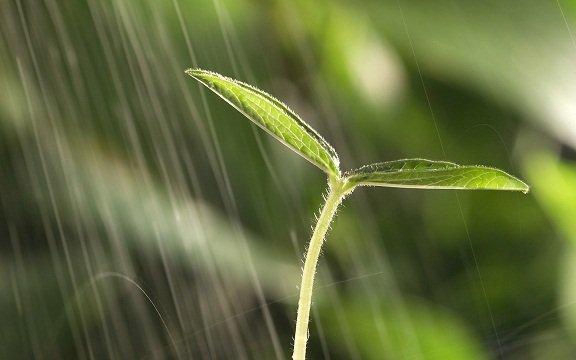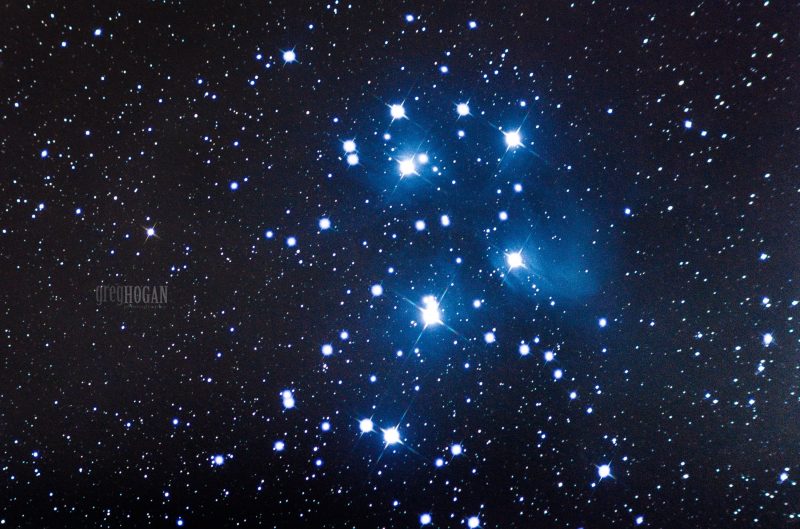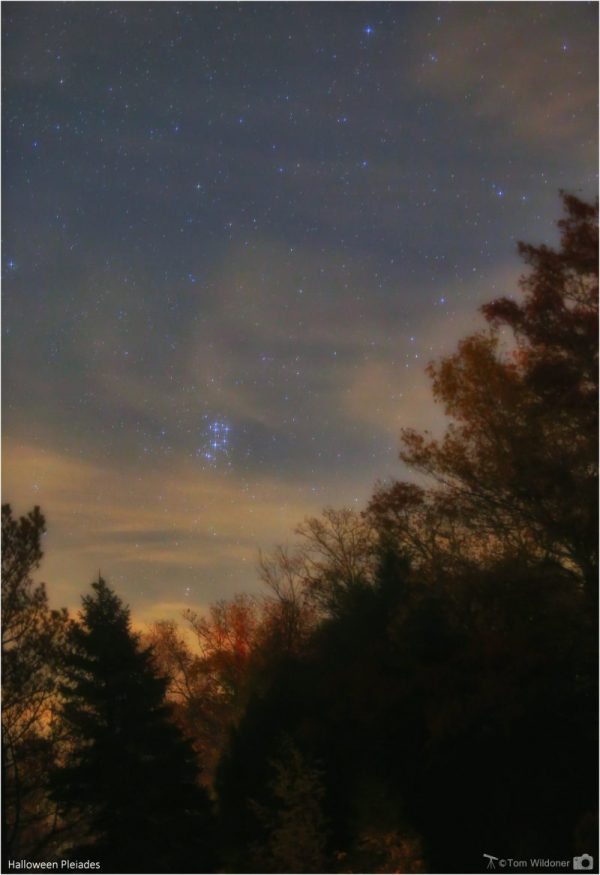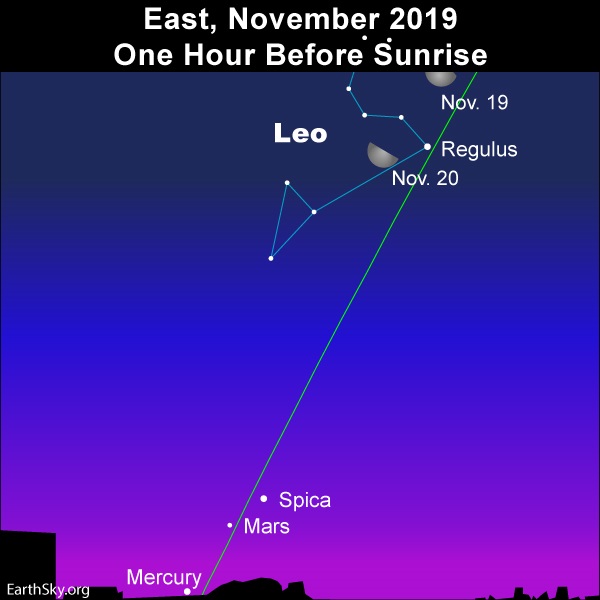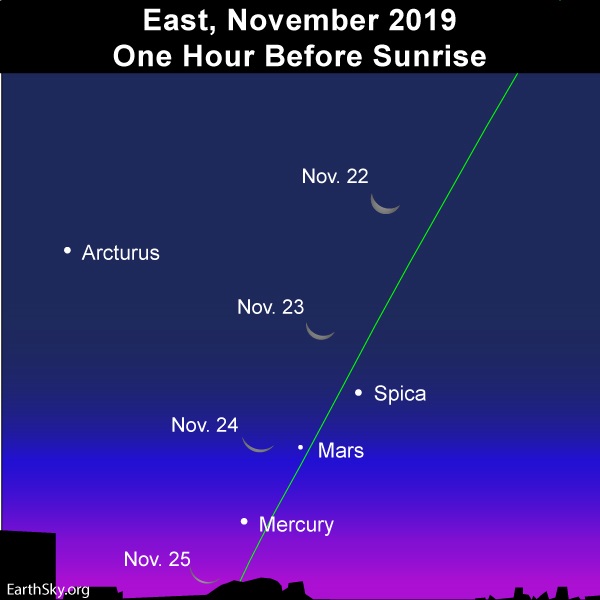
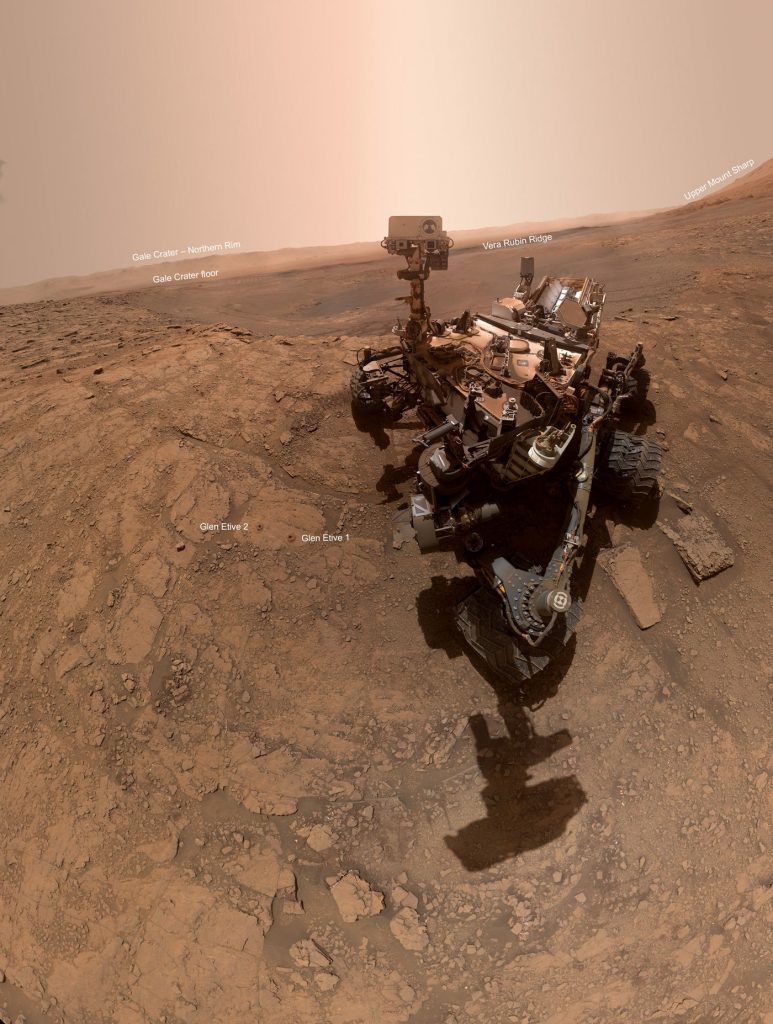
Recent self-portrait of NASA’s Curiosity on Mars, stitched together from 57 individual images taken by a camera on the end of Curiosity’s robotic arm on October 11, 2019 (Sol 2,553). Image via NASA/JPL-Caltech/MSSS. Curious about Curiosity’s self-portraits? Here’s the story behind them.
The presence of methane in Mars’ atmosphere has been a fascinating puzzle for planetary scientists. That’s because, on Earth, methane is linked to life, but it can also be produced geologically. Some of the best data about Mars’ methane has come from the Curiosity rover, which landed on Mars after a daring descent through the atmosphere in August, 2012. Now Curiosity has made another intriguing discovery: oxygen at the rover’s location is behaving in ways that haven’t yet been explained by any known atmospheric or chemical process. The levels of the gas increase much more in the spring and summer months than had been predicted, similar to the still-mysterious methane. The big question, of course, is why?
The baffling peer-reviewed results were just published in the November 12, 2019, issue of the Journal of Geophysical Research: Planets.
Sushil Atreya, professor of climate and space sciences at the University of Michigan, said:
The first time we saw that, it was just mind boggling.
So just what is happening?
EarthSky 2020 lunar calendars are available! They make great gifts. Order now. Going fast!
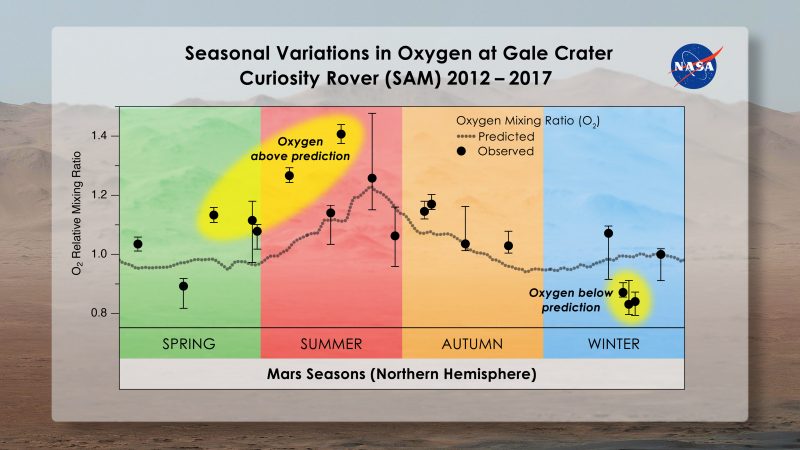
Seasonal variations in oxygen levels in Gale Crater from 2012-2017. So far, scientists haven’t been able to explain these changes. Image via Melissa Trainer/Dan Gallagher/NASA Goddard/NASA.
Curiosity analyzed the composition of the air at Gale Crater over three Mars years (about six Earth years), using its Sample Analysis at Mars (SAM) portable chemistry lab. The results were pretty much what had been expected, and known for years: 95% carbon dioxide (CO2), 2.6% molecular nitrogen (N2), 1.9% argon (Ar), 0.16% molecular oxygen (O2), and 0.06% carbon monoxide (CO). (The methane is normally in much smaller amounts, about 0.00000004% on average).
The nitrogen and argon tend to follow a predictable pattern each year, increasing and decreasing relative to how much carbon dioxide there is. This is related to changing air pressure during the year, since carbon dioxide freezes as snow and ice over the planet’s poles during the winter, which lowers the air pressure. The air pressure rises again when the carbon dioxide evaporates in the spring and summer.
This is where it gets weird. Scientists had expected that the oxygen would follow the same pattern as the nitrogen and argon, but it didn’t. The oxygen level increased much more in spring and summer – as much as 30% – and then dropped back to normal levels, and even below, in the fall. This same process was observed by Curiosity each Martian spring and summer.
So what are the possible explanations? The researchers have considered several possibilities, but none of them explain all of the results.
Was there a problem with the SAM lab? The researchers checked but the instrument was fine and working properly.
Could carbon dioxide or water molecules have released oxygen when they broke apart in the atmosphere due to solar radiation? Probably not, since it would take five times more water vapor than exists to produce the amount of oxygen observed. Carbon dioxide would break up too slowly to generate the same amount of oxygen over such a short time period.
As for the oxygen decrease seen later, could that have been caused by solar radiation breaking apart oxygen molecules? No, since that would be an even slower process, taking up to 10 years.
The scientists involved also think it is unlikely to be caused simply by atmospheric circulation patterns. According to Melissa Trainer, a planetary scientist at NASA’s Goddard Space Flight Center (GFSC) who led the research:
We’re struggling to explain this. The fact that the oxygen behavior isn’t perfectly repeatable every season makes us think that it’s not an issue that has to do with atmospheric dynamics. It has to be some chemical source and sink that we can’t yet account for.
As Timothy McConnochie, assistant research scientist at the University of Maryland, also noted:
We have not been able to come up with one process yet that produces the amount of oxygen we need, but we think it has to be something in the surface soil that changes seasonally because there aren’t enough available oxygen atoms in the atmosphere to create the behavior we see.
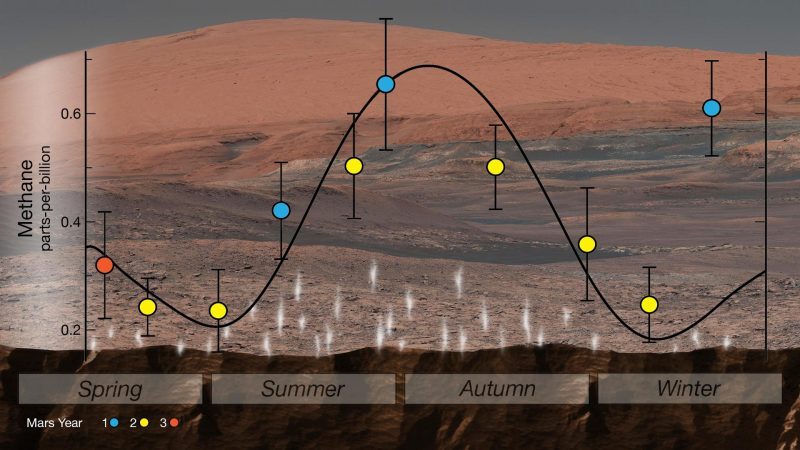
Diagram showing the seasonal cycle of methane as detected by the Curiosity rover in Gale Crater. The methane also varies in concentration on a daily basis as well as seasonal. Image via NASA/JPL-Caltech/Mars Exploration Program.
The paper itself goes into more detail about each of these hypotheses and how none of them adequately explain the results so far. Yet something is producing a lot more oxygen during the warmer months than there should be. Intriguingly, both the oxygen and methane have been observed to fluctuate like this in tandem on at least some occasions, suggesting there may be a common source. As Atreya also noted:
We’re beginning to see this tantalizing correlation between methane and oxygen for a good part of the Mars year. I think there’s something to it. I just don’t have the answers yet. Nobody does.
On Earth, having oxygen and methane together is regarded as a biosignature, since they tend to destroy each other unless they are being continuously produced and fluxed into the atmosphere at relatively high rates. Because of this, the two gases are said to be in a state of thermodynamic disequilibrium.
By far, most of the oxygen and methane on Earth are produced by and/or consumed by life. Could that really be what’s happening on Mars? Or is there still some other unknown chemistry occurring? The Curiosity data showed that the background methane levels decreased at the same time as the oxygen levels did in the last half of each year, although the oxygen increases again earlier in the year than the methane, and is more variable year-to year. The larger “spike” in methane seen by Curiosity however, also occurred during the same period of time as the increase of oxygen in the spring. What all this means isn’t clear yet, and more study will be needed.

Melissa Trainer at Goddard Spaceflight Center (GFSC), who led the new research. Image via NASA/GFSC.
If there really is a correlation between the oxygen and methane on Mars, that could be a potential biosignature. A previous study in 2014 by Shawn Domagal-Goldman of NASA’s Goddard Space Flight Center found that while oxygen and methane by themselves could sometimes be created by non-biological processes, on exoplanets for example, but finding them together would be a more convincing biosignature:
However, our research strengthens the argument that methane and oxygen together, or methane and ozone together, are still strong signatures of life. We tried really, really hard to make false-positive signals for life, and we did find some, but only for oxygen, ozone, or methane by themselves.
These odd fluctuations in the oxygen levels at Gale Crater – with a possible connection to the methane fluctuations and spikes – are a fascinating new mystery for Mars scientists to try and solve. As Trainer summarized:
This is the first time where we’re seeing this interesting behavior over multiple years. We don’t totally understand it. For me, this is an open call to all the smart people out there who are interested in this: See what you can come up with.
Bottom line: NASA’s Curiosity rover has detected unusual increases and decreases in the level of oxygen in the air at Gale Crater. In some ways these are similar to the fluctuations of methane, and may even be connected.
Source: Seasonal variations in atmospheric composition as measured in Gale Crater, Mars
Via NASA
from EarthSky https://ift.tt/33VQDHm


Recent self-portrait of NASA’s Curiosity on Mars, stitched together from 57 individual images taken by a camera on the end of Curiosity’s robotic arm on October 11, 2019 (Sol 2,553). Image via NASA/JPL-Caltech/MSSS. Curious about Curiosity’s self-portraits? Here’s the story behind them.
The presence of methane in Mars’ atmosphere has been a fascinating puzzle for planetary scientists. That’s because, on Earth, methane is linked to life, but it can also be produced geologically. Some of the best data about Mars’ methane has come from the Curiosity rover, which landed on Mars after a daring descent through the atmosphere in August, 2012. Now Curiosity has made another intriguing discovery: oxygen at the rover’s location is behaving in ways that haven’t yet been explained by any known atmospheric or chemical process. The levels of the gas increase much more in the spring and summer months than had been predicted, similar to the still-mysterious methane. The big question, of course, is why?
The baffling peer-reviewed results were just published in the November 12, 2019, issue of the Journal of Geophysical Research: Planets.
Sushil Atreya, professor of climate and space sciences at the University of Michigan, said:
The first time we saw that, it was just mind boggling.
So just what is happening?
EarthSky 2020 lunar calendars are available! They make great gifts. Order now. Going fast!

Seasonal variations in oxygen levels in Gale Crater from 2012-2017. So far, scientists haven’t been able to explain these changes. Image via Melissa Trainer/Dan Gallagher/NASA Goddard/NASA.
Curiosity analyzed the composition of the air at Gale Crater over three Mars years (about six Earth years), using its Sample Analysis at Mars (SAM) portable chemistry lab. The results were pretty much what had been expected, and known for years: 95% carbon dioxide (CO2), 2.6% molecular nitrogen (N2), 1.9% argon (Ar), 0.16% molecular oxygen (O2), and 0.06% carbon monoxide (CO). (The methane is normally in much smaller amounts, about 0.00000004% on average).
The nitrogen and argon tend to follow a predictable pattern each year, increasing and decreasing relative to how much carbon dioxide there is. This is related to changing air pressure during the year, since carbon dioxide freezes as snow and ice over the planet’s poles during the winter, which lowers the air pressure. The air pressure rises again when the carbon dioxide evaporates in the spring and summer.
This is where it gets weird. Scientists had expected that the oxygen would follow the same pattern as the nitrogen and argon, but it didn’t. The oxygen level increased much more in spring and summer – as much as 30% – and then dropped back to normal levels, and even below, in the fall. This same process was observed by Curiosity each Martian spring and summer.
So what are the possible explanations? The researchers have considered several possibilities, but none of them explain all of the results.
Was there a problem with the SAM lab? The researchers checked but the instrument was fine and working properly.
Could carbon dioxide or water molecules have released oxygen when they broke apart in the atmosphere due to solar radiation? Probably not, since it would take five times more water vapor than exists to produce the amount of oxygen observed. Carbon dioxide would break up too slowly to generate the same amount of oxygen over such a short time period.
As for the oxygen decrease seen later, could that have been caused by solar radiation breaking apart oxygen molecules? No, since that would be an even slower process, taking up to 10 years.
The scientists involved also think it is unlikely to be caused simply by atmospheric circulation patterns. According to Melissa Trainer, a planetary scientist at NASA’s Goddard Space Flight Center (GFSC) who led the research:
We’re struggling to explain this. The fact that the oxygen behavior isn’t perfectly repeatable every season makes us think that it’s not an issue that has to do with atmospheric dynamics. It has to be some chemical source and sink that we can’t yet account for.
As Timothy McConnochie, assistant research scientist at the University of Maryland, also noted:
We have not been able to come up with one process yet that produces the amount of oxygen we need, but we think it has to be something in the surface soil that changes seasonally because there aren’t enough available oxygen atoms in the atmosphere to create the behavior we see.

Diagram showing the seasonal cycle of methane as detected by the Curiosity rover in Gale Crater. The methane also varies in concentration on a daily basis as well as seasonal. Image via NASA/JPL-Caltech/Mars Exploration Program.
The paper itself goes into more detail about each of these hypotheses and how none of them adequately explain the results so far. Yet something is producing a lot more oxygen during the warmer months than there should be. Intriguingly, both the oxygen and methane have been observed to fluctuate like this in tandem on at least some occasions, suggesting there may be a common source. As Atreya also noted:
We’re beginning to see this tantalizing correlation between methane and oxygen for a good part of the Mars year. I think there’s something to it. I just don’t have the answers yet. Nobody does.
On Earth, having oxygen and methane together is regarded as a biosignature, since they tend to destroy each other unless they are being continuously produced and fluxed into the atmosphere at relatively high rates. Because of this, the two gases are said to be in a state of thermodynamic disequilibrium.
By far, most of the oxygen and methane on Earth are produced by and/or consumed by life. Could that really be what’s happening on Mars? Or is there still some other unknown chemistry occurring? The Curiosity data showed that the background methane levels decreased at the same time as the oxygen levels did in the last half of each year, although the oxygen increases again earlier in the year than the methane, and is more variable year-to year. The larger “spike” in methane seen by Curiosity however, also occurred during the same period of time as the increase of oxygen in the spring. What all this means isn’t clear yet, and more study will be needed.

Melissa Trainer at Goddard Spaceflight Center (GFSC), who led the new research. Image via NASA/GFSC.
If there really is a correlation between the oxygen and methane on Mars, that could be a potential biosignature. A previous study in 2014 by Shawn Domagal-Goldman of NASA’s Goddard Space Flight Center found that while oxygen and methane by themselves could sometimes be created by non-biological processes, on exoplanets for example, but finding them together would be a more convincing biosignature:
However, our research strengthens the argument that methane and oxygen together, or methane and ozone together, are still strong signatures of life. We tried really, really hard to make false-positive signals for life, and we did find some, but only for oxygen, ozone, or methane by themselves.
These odd fluctuations in the oxygen levels at Gale Crater – with a possible connection to the methane fluctuations and spikes – are a fascinating new mystery for Mars scientists to try and solve. As Trainer summarized:
This is the first time where we’re seeing this interesting behavior over multiple years. We don’t totally understand it. For me, this is an open call to all the smart people out there who are interested in this: See what you can come up with.
Bottom line: NASA’s Curiosity rover has detected unusual increases and decreases in the level of oxygen in the air at Gale Crater. In some ways these are similar to the fluctuations of methane, and may even be connected.
Source: Seasonal variations in atmospheric composition as measured in Gale Crater, Mars
Via NASA
from EarthSky https://ift.tt/33VQDHm











